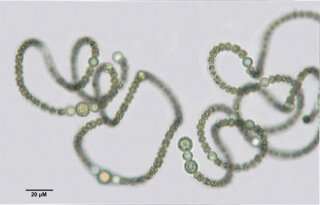New findings enable monitoring for harmful toxin in freshwater environments

An international team of scientists has identified the genes and the biosynthetic pathway that enable certain types of cyanobacteria found in freshwater environments to produce a potent neurotoxin called guanitoxin.
Harmful algal blooms, often involving toxin-producing cyanobacteria (formerly known as blue-green algae), are affecting lakes, rivers, and other freshwater bodies around the world with increasing frequency. Environmental monitoring programs can detect most of the cyanobacterial toxins, but the unusual chemistry of guanitoxin makes it incompatible with standard detection methods.
Understanding the genetic basis for guanitoxin biosynthesis means that molecular diagnostic technologies can now be used for environmental monitoring to detect the presence of guanitoxin-producing cyanobacteria.
The new findings, published May 18 in Journal of the American Chemical Society, include evidence that guanitoxin is likely present in many lakes and reservoirs in North and South America. Guanitoxin has the same mechanism of action as the nerve agent sarin and the banned pesticide parathion, causing acute neurological toxicity that can lead to rapid death. Exposure to it has been associated with the deaths of wild and domestic animals.
"Now that we've found the genes and have biochemically linked them to the production of guanitoxin, we hope that we can use PCR-based detection technologies to predict future toxicity and environmentally monitor this toxin," said Shaun McKinnie, assistant professor of chemistry and biochemistry at UC Santa Cruz and one of three corresponding authors of the paper.
The other corresponding authors are Marli Fiore at the University of São Paolo, Brazil, and Bradley Moore at Scripps Institution of Oceanography at UC San Diego. Fiore's lab isolated a guanitoxin-producing strain of cyanobacteria almost 20 years ago from the Tapacurá reservoir in eastern Brazil. After sequencing the strain's genome, the Brazilian researchers—led by Stella Lima, then a graduate student in Fiore's lab—found a cluster of genes they suspected were involved in guanitoxin production.
Lima, who is first author of the new paper, went to UC San Diego in 2018 to work with Moore, who had done the first biochemical studies of guanitoxin in the 1990s. McKinnie got involved in the project as a postdoctoral researcher in Moore's lab. When he moved to UC Santa Cruz in 2019, his lab continued to work on the guanitoxin biosynthetic pathway in collaboration with the other two labs. Graduate student Jennifer Cordoza led the effort at UC Santa Cruz.
"The whole lab helped contribute to this story, however Jenny really ran with it and validated over half of the pathway herself during the first year of her Ph.D.," McKinnie said. "We've now identified all nine of the enzymes involved in how this organism takes the amino acid arginine and converts it into a specialized toxin."
The researchers confirmed their findings by reconstituting the guanitoxin biosynthetic pathway "in vitro" (in the test tube, without cyanobacteria).
They also searched for the toxin genes in available datasets of raw environmental sequencing data. The search indicated that guanitoxin-producing cyanobacteria are present in a wide range of locations, including Lake Erie near Toledo, Ohio; Lake Mendota in Wisconsin; the Columbia River in Oregon; the Delaware River in Delaware; and several sites in Brazil.
"We found these genes in a variety of different freshwater sources, but nobody has looked for or monitored for this particular toxin environmentally," McKinnie said.
He explained that detecting guanitoxin directly would require a different analytical procedure from the standard methods used in environmental monitoring for toxins. Molecular diagnostic technologies such as polymerase chain reaction (PCR) offer an effective alternative for identifying samples that have the potential to be toxic due to guanitoxin.
"Finding the genes in a sample could then justify a more complex procedure to detect guanitoxin directly," McKinnie said.
The researchers have filed a provisional patent application based on the concept of using the guanitoxin biosynthetic gene sequences they identified in the lab and applying molecular diagnostics using those sequences to find the genes in the environment.
More information: Stella T. Lima et al, Biosynthesis of Guanitoxin Enables Global Environmental Detection in Freshwater Cyanobacteria, Journal of the American Chemical Society (2022). DOI: 10.1021/jacs.2c01424
Journal information: Journal of the American Chemical Society
Provided by University of California - Santa Cruz





















